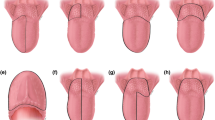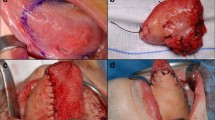Abstract
The appropriate tongue reconstruction method is critical for better functional outcomes. The aim of this study was to determine the optimal reconstructive method for restoring postoperative function based on the extent of resection. We retrospectively reviewed 43 patients with lateral oral tongue cancer who underwent glossectomy between January 2010 and October 2014. Tongue mobility, articulation, verbal diadochokinesis, speech intelligibility and swallowing outcomes were assessed 2–3 years postoperative and were analyzed according to resected tongue volume and the method of reconstruction. In partial glossectomy cases, the secondary intention group had better function in tongue mobility, articulation, and speech intelligibility (p < 0.001 for all) than the free flap reconstruction group. In contrast, in hemi-glossectomy cases, the free flap reconstruction group had better tongue mobility, articulation, verbal diadochokinesis and speech intelligibility (p < 0.05 for all) than the secondary intention group. There was no significant difference in swallowing outcome between the secondary intention and flap reconstruction groups in both partial glossectomy and hemi-glossectomy cases. In conclusion, secondary intention appears to be the most appropriate option after partial glossectomy. However, flap reconstruction is necessary to restore tongue volume and function in patients who undergo a resection of more than half of the tongue volume.
Similar content being viewed by others
References
Hsiao HT, Leu YS, Chang SH, Lee JT (2003) Swallowing function in patients who underwent hemiglossectomy: comparison of primary closure and free radial forearm flap reconstruction with videofluoroscopy. Ann Plast Surg 50:450–455
Shin YS, Koh YW, Kim SH, Jeong JH, Ahn S, Hong HJ, Choi EC (2012) Radiotherapy deteriorates postoperative functional outcome after partial glossectomy with free flap reconstruction. J Oral Maxillofac Surg 70(1):216–220
Joo YH, Hwang SH, Park JO, Cho KJ, Kim MS (2013) Functional outcome after partial glossectomy with reconstruction using radial forearm free flap. Auris Nasus Larynx 40(3):303–307
Sun J, Weng Y, Li J, Wang G, Zhang Z (2007) Analysis of determinants on speech function after glossectomy. J Oral Maxillofac Surg 65(10):1944–1950
de Vicente JC, de Villalain L, Torre A, Pena I (2008) Microvascular free tissue transfer for tongue reconstruction after hemiglossectomy: a functional assessment of radial forearm versus anterolateral thigh flap. J Oral Maxillofac Surg 66(11):2270–2275
Lee DY, Ryu YJ, Hah JH, Kwon TK, Sung MW, Kim KH (2014) Long-term subjective tongue function after partial glossectomy. J Oral Rehabil 41(10):754–758
Matsui Y, Ohno K, Yamashita Y, Takahashi K (2007) Factors influencing postoperative speech function of tongue cancer patients following reconstruction with fasciocutaneous/myocutaneous flaps—a multicenter study. Int J Oral Maxillofac Surg 36(7):601–609
Salibian AH, Allison GR, Armstrong WB, Krugman ME, Strelzow VV, Kelly T, Brugman JJ, Hoerauf P, McMicken BL (1999) Functional hemitongue reconstruction with the microvascular ulnar forearm flap. Plast Reconstr Surg 104(3):654–660
Tarsitano A, Vietti MV, Cipriani R, Marchetti C (2013) Functional results of microvascular reconstruction after hemiglossectomy: free anterolateral thigh flap versus free forearm flap. Acta Otorhinolaryngol Ital 33(6):374–379
Chuanjun C, Zhiyuan Z, Shaopu G, Xinquan J, Zhihong Z (2002) Speech after partial glossectomy: a comparison between reconstruction and nonreconstruction patients. J Oral Maxillofac Surg 60(4):404–407
Hsiao HT, Leu YS, Lin CC (2002) Primary closure versus radial forearm flap reconstruction after hemiglossectomy: functional assessment of swallowing and speech. Ann Plast Surg 49(6):612–616
McConnel FM, Pauloski BR, Logemann JA, Rademaker AW, Colangelo L, Shedd D, Carroll W, Lewin J, Johnson J (1998) Functional results of primary closure vs flaps in oropharyngeal reconstruction: a prospective study of speech and swallowing. Arch Otolaryngol Head Neck Surg 124(6):625–630
Shin MJ, Kim JO, Lee SB, Lee SY (2010) Speech mechanism screening test. Hakjisa Publisher, Seoul
Heller KS, Levy J, Sciubba JJ (1991) Speech patterns following partial glossectomy for small tumors of the tongue. Head Neck 13(4):340–343
Kent RD, Kent JF, Rosenbek JC (1987) Maximum performance tests of speech production. J Speech Hear Disord 52(4):367–387
Salassa JR (1999) A functional outcome swallowing scale for staging oropharyngeal dysphagia. Dig Dis 17(4):230–234
Hara I, Gellrich NC, Duker J, Schon R, Nilius M, Fakler O, Schmelzeisen R, Ozeki S, Honda T (2003) Evaluation of swallowing function after intraoral soft tissue reconstruction with microvascular free flaps. Int J Oral Maxillofac Surg 32(6):593–599
Bokhari WA, Wang SJ (2007) Tongue reconstruction: recent advances. Curr Opin Otolaryngol Head Neck Surg 15(4):202–207
Lam L, Samman N (2013) Speech and swallowing following tongue cancer surgery and free flap reconstruction—a systematic review. Oral Oncol 49(6):507–524
Bressmann T, Sader R, Whitehill TL, Samman N (2004) Consonant intelligibility and tongue motility in patients with partial glossectomy. J Oral Maxillofac Surg 62(3):298–303
Kimata Y, Sakuraba M, Hishinuma S, Ebihara S, Hayashi R, Asakage T, Nakatsuka T, Harii K (2003) Analysis of the relations between the shape of the reconstructed tongue and postoperative functions after subtotal or total glossectomy. Laryngoscope 113(5):905–909
Hohlweg-Majert B, Ristow O, Gust K, Kehl V, Wolff KD, Pigorsch S (2012) Impact of radiotherapy on microsurgical reconstruction of the head and neck. J Cancer Res Clin Oncol 138(11):1799–1811
Author information
Authors and Affiliations
Corresponding author
Ethics declarations
Funding
The authors did not receive any financial support or other external help in preparing this manuscript.
Conflict of interest
The authors declare that they have no conflict of interest.
Ethical approval
The study was approved by the Institutional Review Board of the Hanyang University Guri Hospital.
Informed consent
Informed consent was obtained from all individual participants included in the study.
Rights and permissions
About this article
Cite this article
Ji, Y.B., Cho, Y.H., Song, C.M. et al. Long-term functional outcomes after resection of tongue cancer: determining the optimal reconstruction method. Eur Arch Otorhinolaryngol 274, 3751–3756 (2017). https://doi.org/10.1007/s00405-017-4683-8
Received:
Accepted:
Published:
Issue Date:
DOI: https://doi.org/10.1007/s00405-017-4683-8




